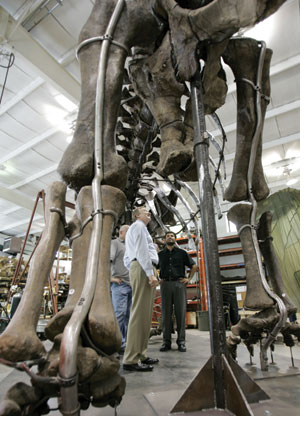Back
 At
times it’s as delicate and exacting as internal
surgery. Other times it takes the appearance of a construction
zone. Still other times it’s apparent that true artists
are at work. It’s the process of taking Pittsburgh’s
oldest residents—the Carnegie Museums dinosaurs—and
making them ready for their fabulous new digs at Carnegie
Museum of Natural History. And it’s all happening,
sometimes simultaneously, at the hangar-like studio of
Phil Fraley Productions in Paterson, New Jersey. At
times it’s as delicate and exacting as internal
surgery. Other times it takes the appearance of a construction
zone. Still other times it’s apparent that true artists
are at work. It’s the process of taking Pittsburgh’s
oldest residents—the Carnegie Museums dinosaurs—and
making them ready for their fabulous new digs at Carnegie
Museum of Natural History. And it’s all happening,
sometimes simultaneously, at the hangar-like studio of
Phil Fraley Productions in Paterson, New Jersey.
For the
past year, team Fraley has been chemically cleaning, chipping,
chiseling, molding, welding, and doing plenty
of heavy lifting as part of this extreme makeover of Carnegie’s
dinosaurs. Their core materials are bones unearthed by
Andrew Carnegie’s intrepid group of dinosaur hunters
a century ago. And these aren’t just any bones: One
femur of an adult sauropod weighs in at 300 pounds; an
entire pelvis of the same creature breaks the scale at
3,000 pounds. The men and women doing the job are sculptors
skilled in metal work, now charged with the task of molding
the steel armature snaking its way through the standing
specimens, holding the bones together; artists who normally
work with clay pottery, now charged with the task of creating
plaster casts of missing bones; and graphic designers who
never dreamed they’d one day be building dinosaurs.
On a hot and sticky day in August—perfect jungle-like
weather if you’re a sauropod from ancient Utah—Bill
DeWalt, director of Carnegie Museum of Natural History,
and Chris Beard, curator of Vertebrate Paleontology, took
news reporters from Pittsburgh, Philadelphia, Washington,
D.C., and the New York-New Jersey area up close to some
mind-boggling history. Although both have been involved
in the planning of Dinosaurs in Their World since the $36
million project began, they still appear in genuine awe
of what’s being created.
“
People who have been viewing these dinosaurs for decades
won’t even recognize them,” exclaims Beard,
as he peers up—way up—at one of the objects
of his admiration. Beard is surveying Apatosaurus louisae,
the 76-foot-long, almost graceful-looking sauropod named
after Andrew Carnegie’s wife Louise. But louisae
hasn’t looked this good—this alive—since
she perished and fell to the ground about 150 million years
ago.
For nearly a century, louisae had stood in the museum’s
now-dismantled Dinosaur Hall, tail down, head hanging,
and looking every bit the part of the big, clunky, peace-loving
vegetarian we thought her to be. But here’s the catch:
Through decades of new findings, including the discovery
of trails of dinosaur footprints frozen in fossilized time,
scientists now know that this dinosaur, although not a
predatory animal, was nothing like the slow, lumbering
dinosaurs of our imaginations.
“
What we’re creating in our new exhibit halls are
scenes that will give visitors a new vision of the dinosaurs
they thought they knew, and a new appreciation for the
world they lived in,” says Beard.
Scene Stealers
Scene one was in the midst of being played out that day
in August, as reporters made their way through Phil Fraley’s
massive studio—walking beneath louisae’s
newly elevated, 30-foot-long swirling tail and loitering
beneath her giant rib cage. Since being disassembled
in Pittsburgh last summer and then shipped to Paterson,
Apatosaurus louisae has been put back together again
in a dynamic new pose. Anything but dormant and docile,
this new louisae is protecting her baby— head swung
to one side, peering at the threat behind her, her tail
in mid-swing, ready to strike.
Her infant Apatosaurus hasn’t
entered the scene yet; that’s the next project for
team Fraley. One of only two baby Apatosaurus skeletons
in existence, this specimen
will be new to the Carnegie Museums dinosaur exhibits and
will play the part of louisae’s baby in peril. The
predator in the scene is an Allosaurus, recently
reassembled into his own dynamic new pose: charging, his
head and neck
outstretched and almost parallel to the ground, his tiny
arms ready to swipe his dinner. Less than half the size
of the giant louisae, this 30-foot animal was fast and
furiously efficient at preying, two-footed, on living creatures
his own size or smaller, such as the baby Apatosaurus.
How this scene ends is anyone’s guess. Just as it’s
anyone’s guess which Tyrannosaurus rex will
be triumphant in another scene that Phil Fraley’s
team will begin constructing early next year. A small model
of the scene
sits off to the side in the studio: the first T. rex, the
museum’s famous type specimen (which means it’s
the scientific model that all other T. rexes are compared
with) looks to be in the middle of a violent dance with
another T. rex intent on depriving him of the carcass of
an Edmontosaurus. “Visitors will literally be able
to circle around this amazing scene,” Beard says.
They’ll
circle, and they’ll wonder: Which one
wins? It doesn’t much matter, since the real winners
of these dramatic scenes of the life and times of dinosaurs
will be the millions of people who, for the next century
and beyond, will be awestruck by the sight of Dinosaurs
in Their World.
“
This is by far the biggest project we’ve ever done,” says
Phil Fraley, who has already managed the biggest dinosaur-hall
projects in the world. “It’s going to be something
fantastic to see.”
Stay tuned.
Back
| Top |